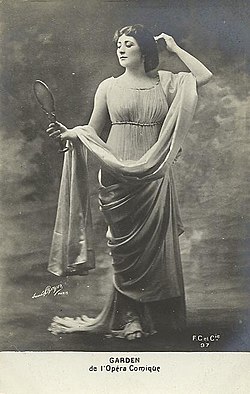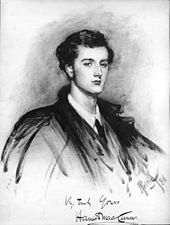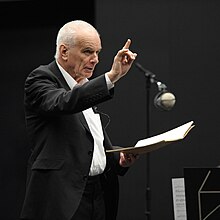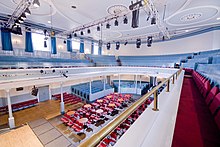Classical music in Scotland

Classical music in Scotland is all
In the mid-eighteenth century a group of Scottish composers including James Oswald and William McGibbon created the "Scots drawing room style", taking primarily Lowland Scottish tunes and making them acceptable to a middle class audience. In the 1790s Robert Burns embarked on an attempt to produce a corpus of Scottish national song contributing about a third of the songs of the Scots Musical Museum. Burns also collaborated with George Thomson in A Select Collection of Original Scottish Airs, which adapted Scottish folk songs with "classical" arrangements. However, Burns' championing of Scottish music may have prevented the establishment of a tradition of European concert music in Scotland, which faltered towards the end of the eighteenth century.
From the mid-nineteenth century classical music began a revival in Scotland, aided by the visits of
Origins

The development of a distinct tradition of
Eighteenth century
The Italian style of classical music was probably first brought to Scotland by the cellist and composer Lorenzo Bocchi, who travelled to Scotland in the 1720s, introducing the cello to the country and then developing settings for Lowland Scots songs. He possibly had a hand in the first Scottish Opera, the pastoral The Gentle Shepherd (1725), with libretto by Allan Ramsay (1686–1758).[7] The growth of a musical culture in the capital was marked by the incorporation of the Musical Society of Edinburgh in 1728 as the successor to the St. Cecilia's Society.[8] By the mid-eighteenth century there were several Italians resident in Scotland, acting as composers and performers. These included Nicolò Pasquali, Giusto Tenducci and Fransesco Barsanti.[9] Scottish composers known to be active in this period include Alexander Munro (fl. c. 1732), James Foulis (1710–73) and Charles McLean (fl. c. 1737).[2] Thomas Erskine, 6th Earl of Kellie (1732–81) was one of the most important British composers of his era, and the first Scot known to have produced a symphony.[6] The Edinburgh Musical Society was so successful in this period that it was able to build its own oval concert hall, St Cecilia's, in 1762. According to Jamie Baxter, by 1775 Edinburgh was a minor, but functioning European musical centre, with foreign and native resident composers and professional musicians.[2]

In the mid-eighteenth century a group of Scottish composers began to respond to Allan Ramsey's call to "own and refine" their own musical tradition, creating what James Johnson has characterised as the "Scots drawing room style", taking primarily Lowland Scottish tunes and adding simple figured basslines and other features from Italian music that made them acceptable to a middle class audience. It gained momentum when major Scottish composers like James Oswald (1710–69) and William McGibbon (1690–1756) became involved around 1740. Oswald's Curious Collection of Scottish Songs (1740) was one of the first to include Gaelic tunes alongside Lowland ones, setting a fashion common by the middle of the century and helping to create a unified Scottish musical identity. However, with changing fashions there was a decline in the publication of collections of specifically Scottish collections of tunes, in favour of their incorporation into British collections.[10]
In the 1790s
Nineteenth century
Also involved in the collection and publication of Scottish songs was Walter Scott (1771–1832), whose first literary effort was Minstrelsy of the Scottish Border, published in three volumes (1802–03). This collection first drew the attention of an international audience to his work, and some of his lyrics were set to music by Franz Schubert (1797–1828), who also created a setting of Ossian.[15]

From the mid-nineteenth century classical music began a revival in Scotland, aided by the visits of
By the late nineteenth century, there was in effect a national school of orchestral and operatic music in Scotland. Major composers included
Major performers included the pianist
Twentieth century to the present day

Drysdale's later work included the tone poem A Border Romance (1904), and the cantata Tamlane (1905).[21] Wallace produced his pioneering symphonic poem about his namesake, medieval nationalist William Wallace AD 1305–1905 (1905); and a cantata, The Massacre of the Macpherson (1910).[20] John McEwen's (1868–1948) more overtly national works included Grey Galloway (1908), the Solway Symphony (1911) and Prince Charlie, A Scottish Rhapsody (1924).[14] Conductor Hugh S. Roberton (1874–1952), founded the Glasgow Orpheus Choir in 1906 and Donald Tovey was appointed the Reid Professor of Music at the University of Edinburgh in 1914.[16]
After World War I, Robin Orr (1909–2006) and Cedric Thorpe Davie (1913–83) were influenced by modernism and Scottish musical cadences.[24] The influence of modernism can also be heard in the work of Erik Chisholm (1904–65) in his Pibroch Piano Concerto (1930) and the Straloch suite for Orchestra (1933) and the sonata An Riobhan Dearg (1939). In 1928 he founded the Scottish Ballet Society (later the Celtic Ballet) with choreographer Margaret Morris. Together they created several ballets, including The Forsaken Mermaid (1940). He was also instrumental in the foundation of the Active Society for the Propagation of Contemporary Music, for which he brought leading composers to Glasgow to perform their work.[24]

The ideas of the
The

Ensembles and major venues
Major Scottish orchestras include:
See also
Notes
- ^ Gasser, M., "Ronald Stevenson, Composer-Pianist : An Exegetical Critique from a Pianistic Perspective" (Edith Cowan University Press, Western Australia, 2013)
- ^ ISBN 0-19-211696-7, pp. 140–1.
- ^ E. Lee, Music of the People: a Study of Popular Music in Great Britain (London: Barrie & Jenkins, 1970), p. 53.
- ISBN 0-7546-3160-5, p. 79.
- ISBN 3039109480, p. 35.
- ^ ISBN 1740593820, p. 33.
- ISBN 0-7546-3160-5, p. 4.
- ISBN 0807132780, p. 41.
- ISBN 1139466089, p. 36.
- ISBN 1139466089, p. 30.
- ISBN 0838756182, p. 77.
- ISBN 0203991117, p. 1054.
- ISBN 0203991117, pp. 16–18.
- ^ ISBN 0748620273, pp. 195–6.
- ISBN 0836958039, p. 99.
- ^ ISBN 0-19-211696-7, pp. 143–6.
- ^ D. Conway, '"Short, Dark and Jewish-Looking": Felix Mendelssohn in Britain', The Jewish Year Book (2009), ed. S. Massil, p. xviii.
- ISBN 052183483X, p. 130.
- ^ "Alexander Mackenzie" Scottish Composers: the Land With Music, retrieved 11 May 2012.
- ^ a b J. Stevenson, "William Wallace", AllMusic, retrieved 11 May 2011.
- ^ a b "Learmont-Drysdale" Scottish Composers: the Land With Music, retrieved 11 May 2012.
- ISBN 0191622435, p. 197.
- ^ ISBN 0748609997, pp. 136–8.
- ^ ISBN 0748620273, pp. 193–8.
- ISBN 0748634746, p. 37.
- ^ ISBN 1858287499, pp. 613–14.
- ISBN 113409454X, pp. 357–9.
- ^ ISBN 1405393556, p. 108.
- ^ ISBN 1740593820, p. 137.
- ISBN 0203484282. p. 345.
- ISBN 1565542274, pp. 176–7.
